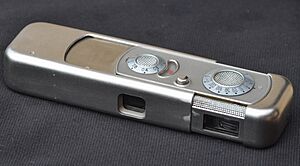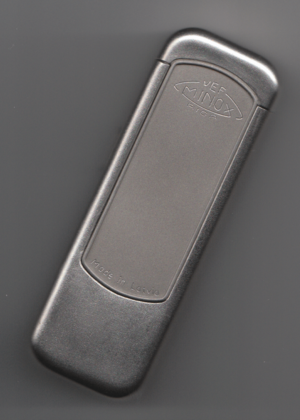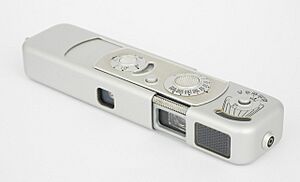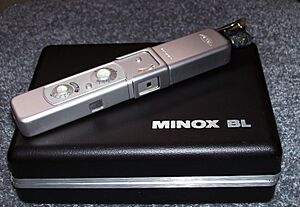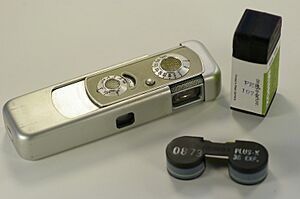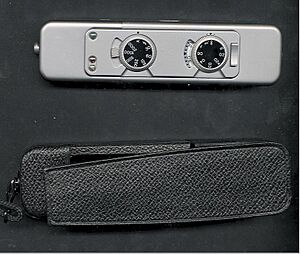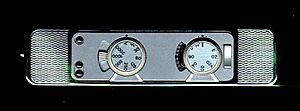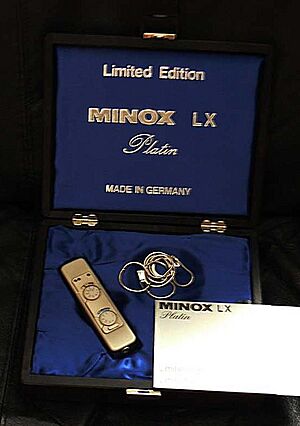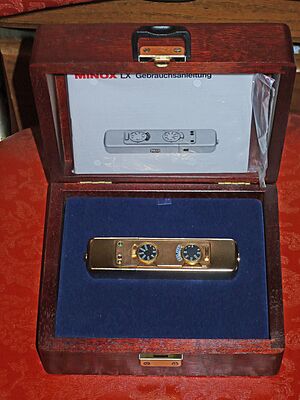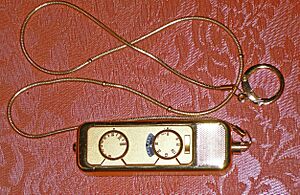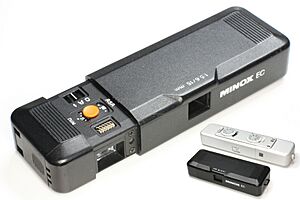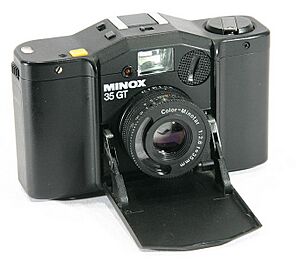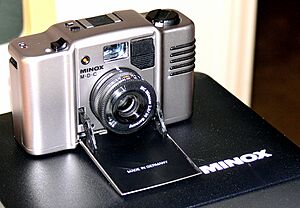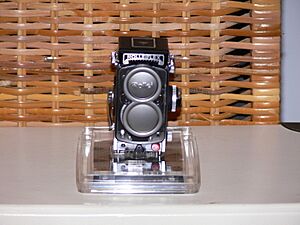Minox facts for kids
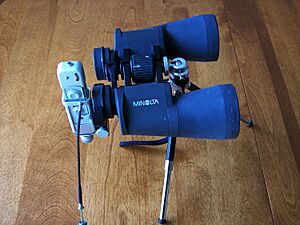
Tele Minox with adapter on prismatic binoculars
|
|
| Industry | cameras, binoculars and other optical equipment |
|---|---|
| Founded | 1945 |
| Founder | Walter Zapp |
| Headquarters | Wetzlar, Germany |
|
Key people
|
Wolfgang Venzl |
|
Number of employees
|
approx. 30 |
Minox (pronounced MEE-noks) is a company famous for making cameras. They are especially known for their tiny "subminiature" cameras.
The very first Minox camera was a super small one. It was thought up in 1922 and finally made in 1936 by Baltic German inventor Walter Zapp. A factory in Latvia called VEF made these cameras from 1937 to 1943.
After World War II, the camera was updated. Production started again in Germany in 1948. Walter Zapp wanted the Minox to be a simple camera for everyone. But because it cost a lot to make, it became a popular luxury item. Right from the start, the Minox also became famous as a spy camera.
Later, Minox started making cameras that used bigger film, like 35 mm film and 110 film. This happened in the 1970s. Today, Minox still makes cool optical gear, like binoculars and other equipment.
Contents
Minox Cameras: A Look Back
From 1936 to 1975, the Minox brand was mostly about its tiny subminiature camera. After 1975, Minox also became known for other products. The most famous of these were the Minox 35 mm compact cameras. These were made from 1975 until 2004.
In 1996, a bigger camera company called Leica bought Minox. But on August 25, 2001, Minox became an independent company again. This happened through a "management buyout," which means the company's leaders bought it back.
The Tiny Minox Subminiature Camera
How the Subminiature Camera Started
The first Minox subminiature camera was invented by Walter Zapp in 1936. Zapp was born in 1905 in Riga, which was then part of the Russian Empire. He later moved to Tallinn, Estonia, where he worked as an engraver and then with a photographer.
He and his friends, Nikolai 'Nixi' Nylander and Richard Jürgens, talked about making a camera you could always carry. Nixi Nylander even came up with the name "Minox" and designed the Minox mouse logo. Richard Jürgens helped fund the first project.
Jürgens contacted a company in Riga, Latvia, called VEF. Zapp showed them his first Minox camera (called UrMinox). He also showed them big pictures made from the tiny negatives. Production of the camera began at VEF in Riga in 1937 and continued until 1943. VEF also got patents for Zapp's inventions in at least 18 countries.
Soon after it came out, the Minox was advertised widely in Europe and America. It didn't become as popular as 35 mm cameras. But it found a special market. Its small size and ability to focus up close also caught the eye of spy agencies.
During World War II, making the Minox was tough. Latvia was taken over by the Soviet Union, then Germany, and then the Soviets again. But cameras were still made during both occupations. The camera became a fancy gift for Nazi leaders and a tool for their spies. Zapp and his team also looked for other places to make the camera in Germany.
After World War II, a new company, Minox GmbH, started making the Minox II in 1948. This was in West Germany. The new camera looked a lot like the first one. But it had a plastic body with an aluminum cover. This made it much lighter and a bit cheaper.
The camera was still seen as a luxury item. It was also used by spies on both sides during the Cold War. Minox kept improving the camera. They added a tiny light meter inside the camera itself, like in the Minox B. The Minox B became the most popular model.
They also made many accessories. These included flashes, tripods, and special stands for copying documents. One accessory even let the camera use binoculars as a telephoto lens! Some special versions of the camera were made with fancy finishes, like gold plating.
The original Riga Minox cameras and the fancy postwar cameras are now collector's items. The Minox TLX camera was sold until September 2014. Today, Minox is part of the Blazer Group GmBH. They now make high-quality sports optics and night-vision devices. Their only cameras are trail cameras for nature.
The Minox as a Spy Camera
The Minox subminiature camera was very interesting to spy agencies. This included groups in America, Britain, Germany, and Eastern Europe. Its small size and ability to focus on close-up objects made it perfect for secret missions. These missions included spying or copying documents.
Records show that the US Office of Strategic Services bought 25 Minox cameras in 1942. The Minox was used by both the Axis and Allied spies during World War II. Later versions were used until the 1980s.
A Soviet spy named John A. Walker Jr. used a Minox C camera. He photographed secret documents and codes from the US Navy. This was a very damaging act of spying during the Cold War.
Most Minox subminiature cameras came with a special 18-inch measuring chain. This made it easy to copy letter-sized documents. The use of the Minox in spying has been shown in Hollywood movies and TV shows. Some Minox ads in the 1980s even played up the "spy camera" story.
How Minox 8×11 Cameras Work
The first Minox camera, made in Riga, had a brass body with a stainless steel cover. This cover slid open or closed to show or hide the lens and viewfinder. Sliding it also moved the film forward. It had a special lens that focused as close as 20 cm (about 8 inches). Because the image was so small, the lens didn't need a part called a diaphragm.
The Minox subminiature camera is very small: 80 mm × 27 mm x 16 mm (about 3.1 x 1.1 x 0.6 inches). It weighs 130 grams (about 4.6 ounces).
Minox cameras take pictures that are 8×11 mm on the film. The film itself is 9.2 mm wide. This is less than a quarter the size of 35 mm film. Unlike 35 mm film, it doesn't have sprocket holes. The film comes in a small cartridge. Early cameras could hold up to 50 pictures. Later models held 15, 30, or 36 pictures.
Early Minox cameras had a mechanical shutter. Later models, like the Minox C, LX, and TLX, had an electronic shutter. When the camera is closed, the lens and viewfinder are protected.
On top of the viewfinder, there's a filter bar. You could slide a yellow, green, or orange filter in front of the lens. Later models, starting with the BL, only had a Neutral Density filter.
For older Minox cameras (Riga to Minox B), the film moved forward every time you closed the camera. This happened whether you took a picture or not. From the Minox BL onwards, the film only moved forward when you took a picture.
Minox cameras have a focusing dial on top. This lets you focus from 20 cm (8 inches) to far away. All Minox cameras, except the EC and MX, have a special viewfinder. It moves with the focusing dial to correct for something called "parallax." This helps make sure what you see in the viewfinder is what the camera captures.
The Minox TLX camera was available until September 2014.
Popular Minox Models
Here are some of the main Minox camera models:
- Riga – Made from 1938/39 to 1942/43. This was the first model.
- A – Made from 1948 to 1969. This included models like the Minox II and III.
- B – Made from 1958 to 1972. It had a light meter built in.
- C – Made from 1969 to 1978. This was the first Minox with electronic exposure control.
- BL – Made from 1972 to 1973. It had a different type of light meter and only advanced film when a picture was taken.
- LX – Made from 1978 onwards. This was an electronic model, often in fancy finishes. The TLX was a special version.
- EC – Made from 1981 to 2004. This was a more affordable and very small Minox.
- MX – A unique model with a simple design.
About 944,500 Minox 8x11 cameras were made in total!
Minox 8×11 Accessories
Minox made many cool accessories for their tiny cameras:
- Minox tripods
- Minox copy stands, for taking pictures of documents
- Minox film slitter, to cut film
- Minox enlargers, to make big prints from tiny negatives
- Minox flashguns, for taking pictures in the dark
- Minox binocular adapter, to use binoculars as a telephoto lens
- Minox daylight development tank, for developing film at home
- Minox film wallets, to carry film
Minox 35 mm Cameras
Minox 35 mm Compact Cameras
In 1974, Minox released a very small 35 mm film camera called the Minox EL. It was the first in the Minox 35 mm series. These cameras had a unique lens cover that folded down. When you opened it, a sharp 35 mm lens came out.
The Minox 35 cameras were known for their excellent lenses. They also had a great system for measuring light, which worked well even in dim conditions. Some models had a timer for taking pictures.
Until 1995, Minox 35 cameras were thought to be the smallest cameras for standard 35 mm film.
- Minox 35
Other Cool Minox Products
Minox 110 Camera
Minox also sold a camera that used 110 film, called the MINOX 110S. This camera had a special lens and a flash. It was the only Minox camera with a "rangefinder," which helps you focus. People say the 110S takes great pictures with modern 110 film.
Miniature Retro Cameras
Minox also offered tiny cameras that looked like famous old film cameras. These were made by a Japanese company called Sharan Megahouse. They included miniature versions of:
- Leica cameras
- Rolleiflex cameras
- Zeiss Contax I
- Hasselblad SWC.
These tiny cameras used Minox 8x11 film.
Minox Digital Cameras
Later, Minox also started making digital cameras.
Digital Miniature Retro Cameras
They made digital versions of the tiny retro cameras too:
- DCC Rolleiflex AF 5.0
- DCC Minox Leica M3
- Rolleiflex minidigi
- DCC 5.1 and DCC 14mp
Minox DSC Digital Spy Camera
In 2008, Minox announced a new tiny digital camera called the DSC (Digital Spy Camera). It had a 3-megapixel sensor. It looked a bit like the classic Minox LX camera.
What Minox Makes Today
Today, Minox focuses on making high-quality optical products. These are used for:
- Watching nature and wildlife, like birds or animals in the forest.
- Boating and water sports.
- Hunting.
Their current products include:
- Binoculars
- Riflescopes (for hunting)
- Digital trail cameras (cameras that take pictures of animals in the wild)
- Spotting scopes (powerful telescopes for viewing distant objects)
- Night vision equipment
- Macroscopes (for looking at very small things up close)
See also
- Walter Zapp
- VEF
- List of digital camera brands




